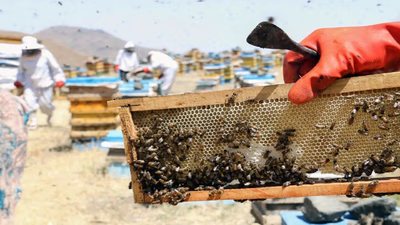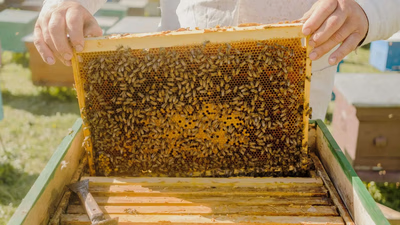
Honey production boosts Middle East economies and trade relations.
Honey plays an important role in the gross national product and income of Middle Eastern countries. Honey is produced as an agricultural product in many Middle Eastern countries. Local honey production leads to job creation and added value in the agricultural sector. Therefore, the gross national production of countries increases through the sale of honey to domestic and foreign markets. Many countries in the Middle East, especially Iran, Turkey, and Saudi Arabia, are known as exporters of honey in the world markets. Exporting honey to other countries leads to foreign exchange and an increase in gross national income. This export can help the trade balance and earn foreign currency for countries.
Honey is introduced as a popular tourism product in many countries of the Middle East. Tourists may buy local honey as a souvenir and add this income to the countries tourism industry. In addition, local honey trade in domestic and foreign markets also helps the development of countries' economies. Honey production can help to develop villages and create employment in rural areas. Many honey farms are located in rural areas, especially in Middle Eastern countries. These farms can provide sources of income for the local community and help reduce migration from the villages and strengthen the regional economy.
Many countries in the Middle East, including Iran, Turkey, Saudi Arabia, Yemen and the United Arab Emirates , are known as exporters of honey in the world markets. Honey produced in these countries is exported to other countries and is offered as a valuable product in international markets. At the same time, some countries in the Middle East need to import honey. Some countries that do not produce enough honey to meet domestic needs may import honey from other countries. This import can help meet the needs of the domestic market and related industries.
Local honey trade is also booming in Middle East countries. Middle Eastern countries may trade their local honey with other countries in the region or internationally. This trade can help exchange technology and experiences in the field of honey production and processing and strengthen trade relations between countries. Honey plays an important role in the import and international trade of the Middle East countries and can contribute to economic development and added value in these countries.
To sell honey in Middle East countries, you can focus on local marketing. Offer local honey products in local shops, markets and restaurants. Also, use the characteristics and quality of your honey to attract local customers through local advertising such as radio, television and social media. Middle Eastern countries are also known as honey exporters. Therefore, if you are a honey producer, you can take advantage of this opportunity and export your honey to other countries in the Middle East region and even internationally. For this purpose, you can cooperate with local merchants and distributors and use international trade fairs and events to attract foreign customers.
In Middle Eastern countries, you can optimize your marketing by researching your target markets and potential customer needs. For example, you can focus on promoting honey with natural properties, cherry honey, or honey grown from certain plants. Also, paying attention to the religious and cultural needs of each country and using honey in preparing local foods and desserts can be helpful. In the honey market, product quality is very important. Therefore, providing excellent quality and using sustainable and organic production methods can help you attract customers and generate more interest. In dealing with customers, emphasizing branding and explaining the special benefits of your honey can also be effective.
In this area, some countries may allow the import of honey only from producers who meet the necessary permits and standards. Therefore, make sure that your honey complies with the relevant standards and that you have obtained all necessary permits. Some countries in the Middle East have popular and reliable brands in the field of honey production and distribution. Cooperating with these brands and entering their distribution network can help you increase access to markets and increase customer trust.
-

Honey production in South West Asia is influenced by diverse flora and climatic conditions, resulting in unique flavors and health benefits. The region"s honeys are known for their antibacterial, antioxidant, and potential anticancer properties. Key areas for honey production include the Alborz mountains in Iran, the Caucasus Mountains, and the Himalayan region. Each area offers distinct floral sources such as saffron, lily, and apricot, contributing to the honey"s unique taste and health benefits. Factors like weather conditions, plant diversity, and beekeeping practices play a crucial role in determining honey quality. Additionally, political stability and legal regulations impact beekeeping activities across these countries. The rich biodiversity of the Middle East enhances the potential for high-quality honey production that stands out globally.
-

Honey significantly contributes to the gross national product and income of Middle Eastern countries, particularly in Iran, Turkey, and Saudi Arabia. The local production of honey not only creates jobs but also adds value to the agricultural sector, enhancing the overall economy. Exporting honey generates foreign exchange and boosts gross national income, while also serving as a popular tourism product. Tourists often purchase local honey as souvenirs, further benefiting the tourism industry. Additionally, honey production supports rural economies by providing income sources and reducing migration from villages. While many Middle Eastern countries are known for their honey exports, some also import honey to meet domestic demands. This trade fosters technology exchange and strengthens regional trade relations. To effectively market honey in these regions, producers should focus on local advertising and highlight the unique qualities of their products.
Collaborating with local merchants and participating in international trade fairs can enhance export opportunities. Understanding target markets and customer preferences is crucial for successful marketing strategies. Emphasizing product quality through sustainable practices can attract more customers, while compliance with import standards is essential for accessing certain markets. Partnering with established brands can further increase market reach and consumer trust.
-

Middle Eastern and Southwest Asian countries, including Iran, Saudi Arabia, Turkey, and the UAE, are key players in honey production and consumption. Each nation has unique honey varieties; for instance, Iran is renowned for saffron and wildflower honey. The region"s rich cultural heritage incorporates honey into local cuisine, with per capita consumption varying: approximately 1 kg in Iran, 1-2 kg in Saudi Arabia, and 0. 5-1 kg in Turkey. Notably, Iran stands out as a leading exporter of honey in West Asia, while Turkey also contributes significantly to global markets. Saudi Arabia is a major importer due to high domestic demand, alongside the UAE and Iraq. The export market includes diverse destinations across Europe and Asia, with specialty honeys like saffron and rosemary gaining traction. Beyond culinary uses, honey finds applications in cosmetics and pharmaceuticals.
Understanding these dynamics offers valuable insights into the regional trade landscape. "
-

In the West Asian food market, jam and honey differ significantly in ingredients, production methods, cultural significance, and market dynamics. Jam is made from fruits, sugar, and pectin, while honey is a natural product derived from bees. Culturally, jam is used as a spread or in desserts but lacks the deep-rooted significance of honey, which is revered for its health benefits and historical importance. The market presence of jam is steady with local production using regional fruits like figs and apricots. In contrast, honey enjoys high demand due to its culinary versatility and perceived health advantages. Countries like Yemen and Saudi Arabia are known for their premium honey varieties. While both products are available in local markets, honey generally commands a higher price point due to its nutritional value and quality. Jam"s consumption varies by region but tends to be less popular than honey overall.
Factors influencing the trade of both products include cultural preferences, economic conditions, and changing consumer habits. Honey"s rich nutrient profile contributes to its popularity as a natural sweetener in cooking and baking, while jam offers diverse flavors reflecting local harvests.




